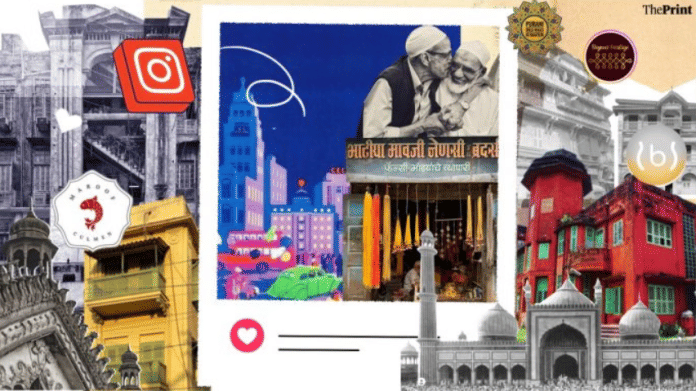Thank you dear subscribers, we are overwhelmed with your response.
Your Turn is a unique section from ThePrint featuring points of view from its subscribers. If you are a subscriber, have a point of view, please send it to us. If not, do subscribe here: https://theprint.in/subscribe/
By Prof. Hitesh D. Raviya
The Architecture of Memory
Every civilisation encodes its values in space and story. For India, the temple was once the axis of memory. It was never a site of worship alone; it was a centre of learning, artistry, astronomy, philosophy, ecology, and community exchange. Temples housed libraries, nurtured poets, trained musicians, and provided moral orientation. Their very architecture was metaphysics in stone. Their festivals were not spectacles but seasonal recalibrations of the human spirit with cosmic rhythm.
The temple in Indic life was not an isolated “religious” site but a civilisational organ, where learning, devotion, aesthetics, and ethics were woven together. To understand the long erasure of Hindu memory, one must begin with the slow disintegration not only of temple structures but of the role they played as knowledge centres.
From Disruption to Displacement
The decline of temples as intellectual hubs began with violent disruption, waves of iconoclasm and invasions that decimated temple clusters. Nalanda, Takshashila, Somnath, and Kashi were not only attacked for wealth but because they embodied wisdom. Invaders understood that burning manuscripts and silencing scholars was the surest way to weaken a civilisation.
What followed under colonial rule was subtler but equally damaging: temples were stripped of their epistemic legitimacy. The British redefined them as spaces of “religion,” detached from knowledge and culture. In their place came the textbook, printed, standardised, and often emptied of civilisational depth. Oral transmission, embodied practice, philosophical dialogue gave way to rote learning within a colonial framework.
The Schooling of Forgetfulness
The colonial school system displaced indigenous institutions, pathshalas, tols, gurukulas, agraharas, that had offered rigorous education in grammar, logic, astronomy, medicine, and arts. In their stead arose English-medium schools designed to produce clerks and interpreters. Learning became information rather than illumination, conformity rather than contemplation.
Textbooks reinforced this narrowing. Epics became fairy tales. The Upanishads were labelled mystical curiosities. Dharma was reduced to “religion.” Indian history often began with invaders. Knowledge was considered valid only when processed through European categories. A culture that had once cultivated shraddhā (reverence), anubhava (experience), and paramparā (lineage) was schooled into forgetfulness, trained to see itself through someone else’s gaze.
Marginalising the Sacred
The post-independence republic deepened this rupture. To build a secular state, India often confused secularism with civilisational amnesia. To avoid “religious bias,” it erased civilisational reference altogether. Temples were bureaucratised; their revenues appropriated, their autonomy curtailed. Even as churches and mosques retained cultural legitimacy, Hindu temples were treated with suspicion, reduced to ritual centres rather than holistic institutions.
This asymmetry shaped education too. Dharmic frameworks were excluded from curricula. Students learned of Darwin but not of Sāṃkhya, of Freud but not of Patanjali, of Marx but not of Kautilya. Indian ethics, aesthetics, and epistemologies were silenced or caricatured. The result was a generation fluent in global categories but alienated from its own soil.
The De-Sacralisation of Arts and Sciences
Nowhere was this erasure clearer than in the arts and sciences. Dance, once temple offering, was recast as performance. Music, once nāda yoga, was rebranded as entertainment. Astronomy, Ayurveda, and metallurgy, robust sciences, were dismissed as superstition because they refused to separate fact from value.
Social sciences too were recast through borrowed frameworks. Caste was reduced to hierarchy, ignoring its vocational origins. Gender debates imported Western binaries, overlooking India’s spectrum of feminine power, from Gargi and Maitreyi to Shakti. Economics ignored indigenous categories like dāna (charity) and aparigraha (non-possession), replacing them with capitalist or socialist models.
By de-sacralising knowledge, India amputated limbs of its civilisational body.
Remembering to Rebuild
The journey back cannot be nostalgic mimicry. It must be conscious regeneration. A dharmic education for the 21st century does not mean replacing science with scripture or putting idols in classrooms. It means reintegrating Indic categories into contemporary learning. Ecology must include pṛthvī sūkta and bhūmi smṛti. Law must engage with dharmashastra. Psychology must read Patanjali alongside Freud. Aesthetics must study rasa theory with the same seriousness as Aristotle.
Policy already gestures toward this direction. The National Education Policy 2020 recognises Indian Knowledge Systems and holistic development. Some institutions experiment with Sanskrit pedagogy, Vedic sciences, and gurukula-inspired methods. But these remain peripheral. For civilisational renewal, integration must become mainstream, not as electives, but as foundations.
Beyond Policy: A Civilisational Blueprint
This reclamation demands more than syllabi. It requires teachers trained to move between traditions, curricula that treat Sanskrit texts as living knowledge, and a national mindset that recognises epistemic justice. A civilisation has the right to teach its children in its own categories, not only borrowed ones.
The temple must once again be seen not as superstition but as a holistic space of ethics, aesthetics, and knowledge. The textbook must not erase dharmic frameworks out of misplaced neutrality. The student must no longer be asked to choose between faith and intellect, past and future.
Conclusion
The erasure from temples to textbooks was long, deliberate, and damaging. But it was not total. Civilisational memory endures, in families, festivals, arts, and idioms. The task now is not to replicate ruins but to reweave continuity. To remember that vidyā once meant illumination, not literacy. That education was meant to cultivate viveka (discernment) and sthiti prajñā (steady wisdom), not only employability. That temples once shaped not only devotion but imagination.
If India can re-anchor its textbooks in the spirit of its temples, its classrooms in the wisdom of its courtyards, it will not regress, it will regenerate. For no civilisation can walk confidently into the future if it has forgotten where its knowledge once lived.
These pieces are being published as they have been received – they have not been edited/fact-checked by ThePrint.


